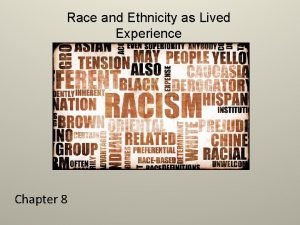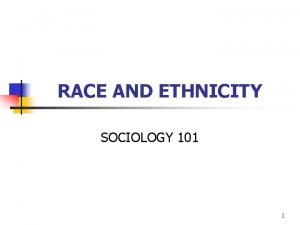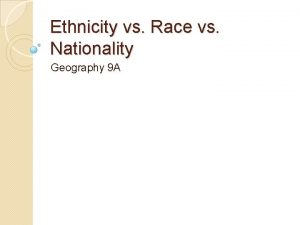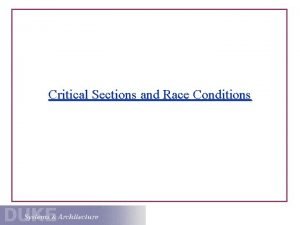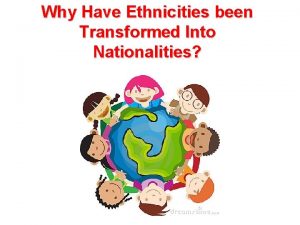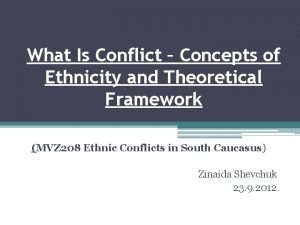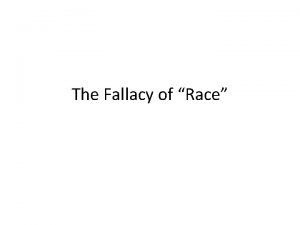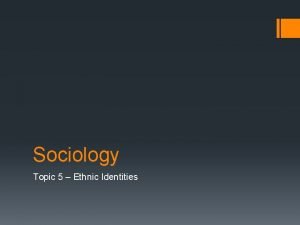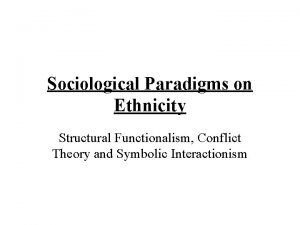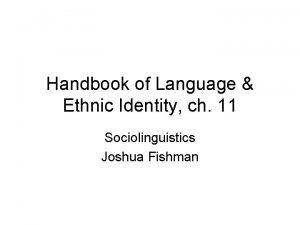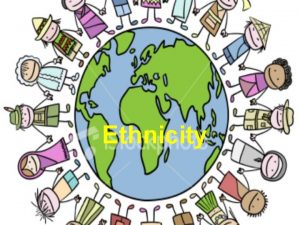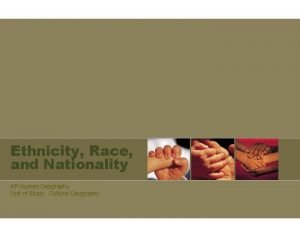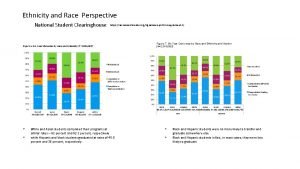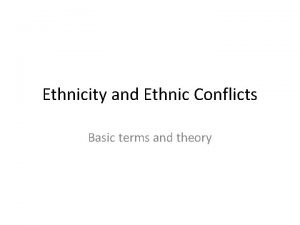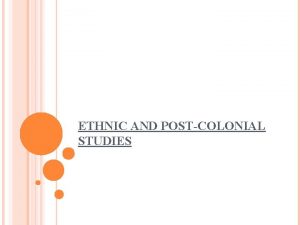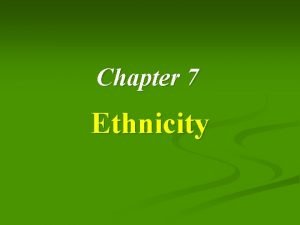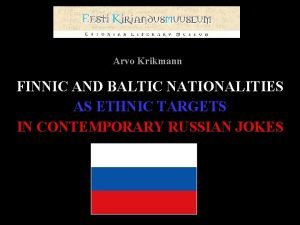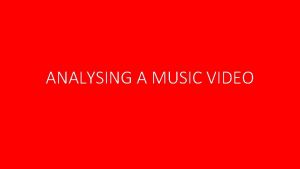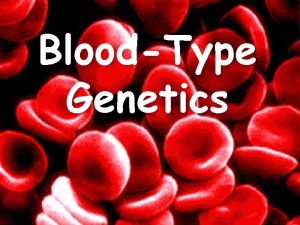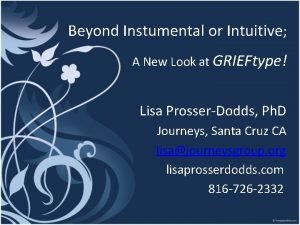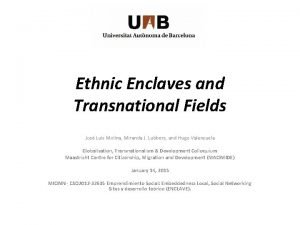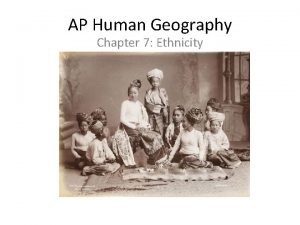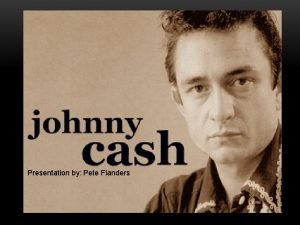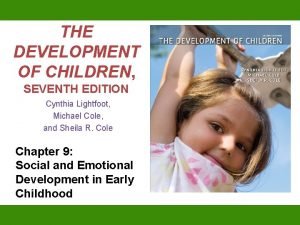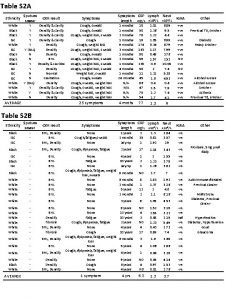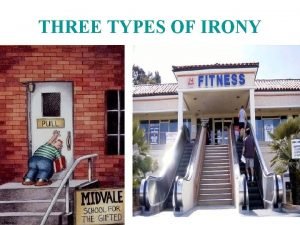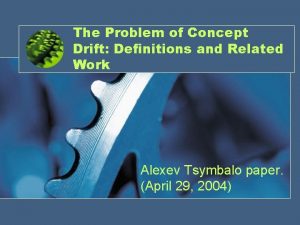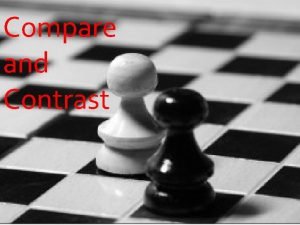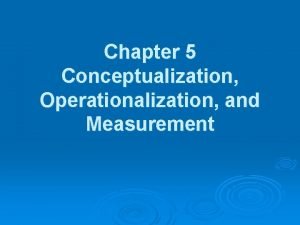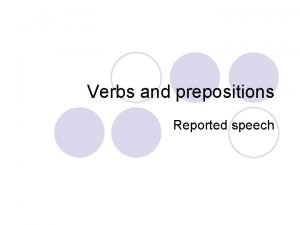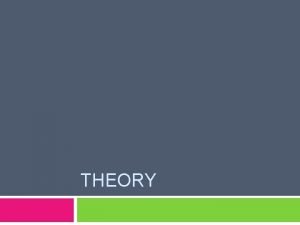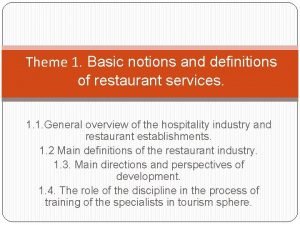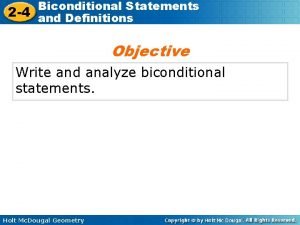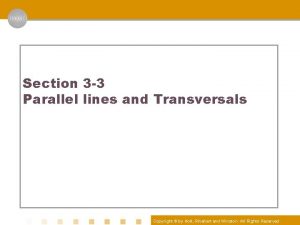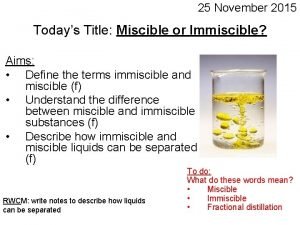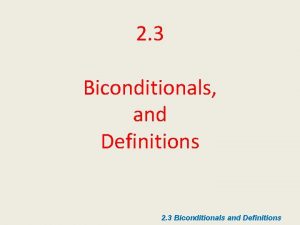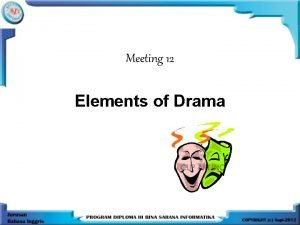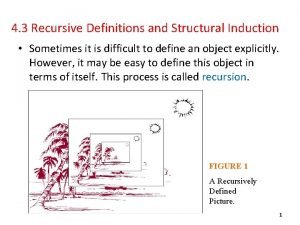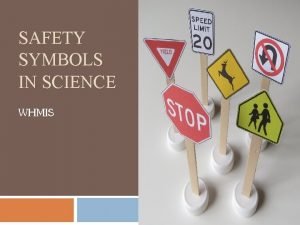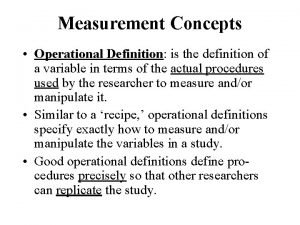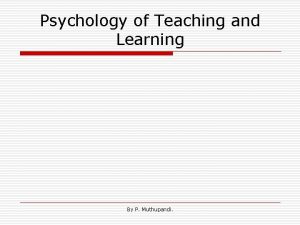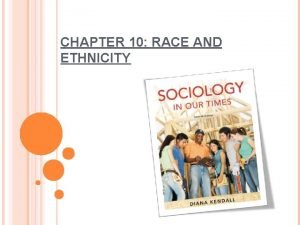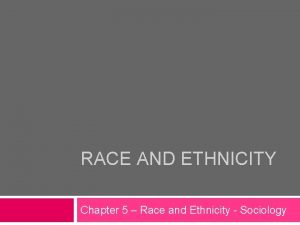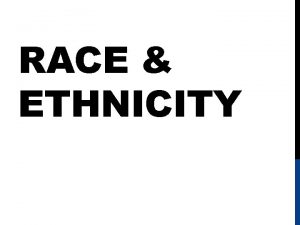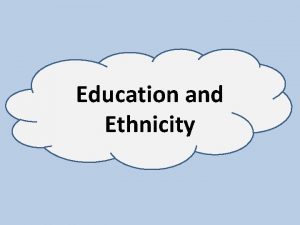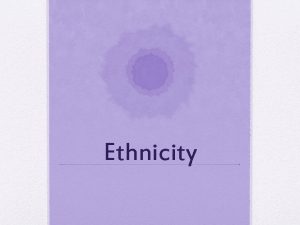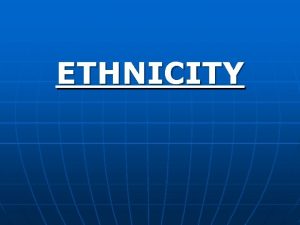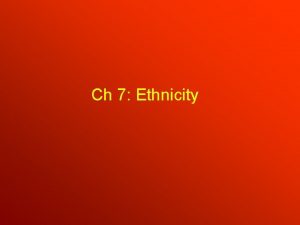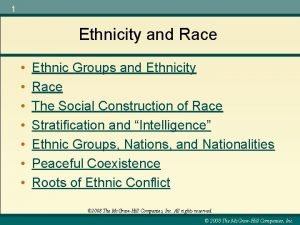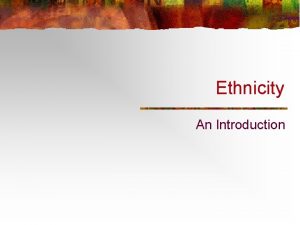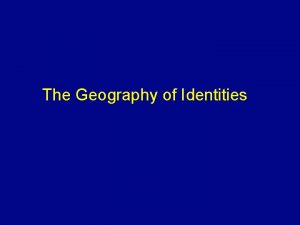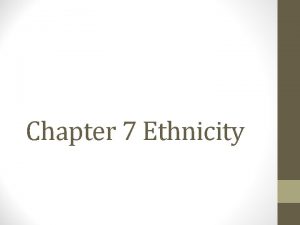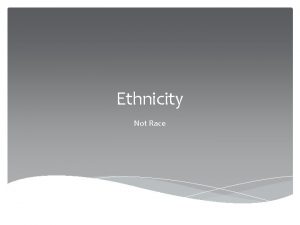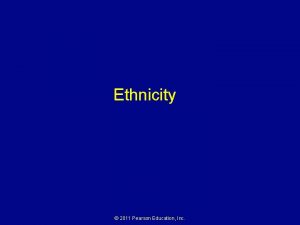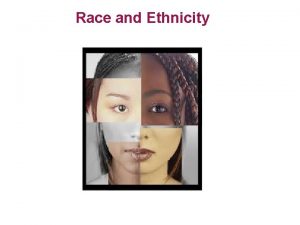RACE AND ETHNICITY AGENDA 1 DEFINITIONS RACE vs











































































- Slides: 75

RACE AND ETHNICITY

AGENDA 1. DEFINITIONS –RACE vs. ETHNICITY 2. ETHNIC SOCIALIZATION 3. ETHNIC HISTORY IN CANADA

DEFINITIONS-

RACE AND RACISM DEFINED A race is a group that is treated as distinct in society based on certain PHYSICAL characteristics. RACISM= groups labeled as inferior by powerful groups in society, Racialization= is when a race is singled out for differential and unfair treatment.

RACE AND ETHNICITY RACIAL GROUPS- FOUR OR FIVE IN THE WORLD GROUP IDENTIFIED BY PHYSICAL FEATURES NEGROID<CAUCASOID<MONGOLOID>AUSTROLOID>MAYLA ETHNIC GROUPS –hundreds in the world…Many cultural categories

ETHNICITY Term has its roots in the Greek word `ethnos’ meaning people. (We the people) Ancient Greeks associate cohesive groups of people formed on the basis of kinship as Tribe or Race. Ethnic groups were sub-divisions. Cohesive groups.

THEODORSON AND THEODORSON 1975 Defines ethnic groups as a collectives with: 1. A common culture 2. A sense of identity -exists as a sub- group in a larger society. 3. Different cultural characteristics from members of the host society.

MINORITY STATUS Ethnic groups are often referred to as cultural minorities. 1. Common cultural bond 2. Sense of identification with and a sense belonging to the group 3. The group views itself as minority DIFFERENT THAN the Host culture…i. e. In Canada the Host culture is Anglo-European.

CONTEXTS Heterogenious/Homogenious Ethnicity is more significant within heterogeneous environments. Why?

THE MAJORITY VS MINORITY IN MAJORITY CONTEXT , PEOPLE ARE LESS CONCERNED WITH THEIR SPECIFIC ETHNIC GROUP A MAJORITY FEEL LESS THREATENED BY OUTSIDERS …. THEREFORE, A MAJORITY CULTURE THINKS LESS OF GROUP SOLIDARITY

CULTURAL BONDS Unify ethnic groups. They include: 1. Language, 2. religion, 3. folkways and mores, 4. styles of dress.

CULTURAL BONDS 5. 6. 7. 8. foods, occupational specialization, social values, aesthetic standards

ETHNIC SOCIALIZATION F. Elkin (1964)

ETHNIC SOCIALIZATION IDENTITY AND EGO F. Elkin (1964) argues that children take on their racial/ethnic identity from the national collectivity from which their parents are members.

FRED ELKIN (1964) Any group interested in ensuring that its ethnic continuity is maintained, must explore: 1. the strategic significance of family. 2. Family is inextricably linked to the vitality and persistence of ethnicity. 3. Family is the first line of defense against the corrosive processes of assimilation.

EGO EXTENSION Elkin (1964) claims that, the process is referred to as ego extension and is a fundamental part of the socialization process of children.

ETHNIC SOCIALIZATION = EGO EXTENSION Within the context of family, the child undergoes a two pronged process of self-designation whereby they 1. link themselves and their family to certain groups. 2. set themselves & family apart from Other groups. US vs. Them

AWARENESS LEADS TO IDENTITY The literature suggests that children are aware of their ethnicity at age 3 or 4. A child’s sexual identity comes first followed by their ethnic identity. A child's ethnic identity is firmly established by age 5 or 6.

ETHNIC AWARENESS Children think of their ethnic identities at age 5, first in terms of external attributes such as: 1. -festivals 2. -language 3. -special schools

EGO EXTENTION BY 7 OR 8 YRS. 4 -belief systems 5 -values 6 -feelings of pride and attachment - they may find These feelings do not always correspond with the feelings of others. (insider and outsider)

EGO EXTENSION Ego extension leads to the varying ways in which individuals view the world. ETHNICITY BECOMES PART OF SELF”””

EGO EXTENSION – IS BOTH AFFECTIVE AND COGNITIVE Affectional (emotional), and cognitive awareness flourishes when the sentiments and emotions related to ethnicity becomes an entrenched layer the person's psychological make-up. Cognitive- thinking about self in regard to ethnicity.

EGO EXTENSION=PRIDE AND ATTACHMENT BEYOND SELF AND FAMILY Where attacks on the person's group become personal attacks and when award upon the group become individual awards. Ie. Italian after winning the world cup. By the teens, ethnicity becomes a key layer of social identity.

CANADA Multidimensional in terms of ethnic patterns: Uni-cultural-British, Anglo Saxon Dominance 1763 Bicultural-French and English Charter groups 1963 -1968 Multicultural-since 1972 Official. .

CANADIAN UNICULTURALISM Canada was never a melting pot: Anglo Dominance combined with racism and nativism. However… Postwar immigration, went far to change this.

BR AND FR. ORIGINS Of this population of about 22. 4 million, nearly one-half (46%), or about 10. 3 million, reported only British Isles, French and/or Canadian ethnic or cultural origins.

CANADIAN ETHNIC ORIGINS STATISTICS CANADA 2001

BRITISH ANCESTRY. The largest proportion - 21% of the total population aged 15 years and older - was comprised of those of only British ancestry.

FRENCH AND ENGLISH_FOUNDING CULTURES An additional 10% of the total population reported only French origins, including French Canadian; 8% reported Canadian origins; and 7% had a mix of British, French and/or Canadian origins.

OTHER EUROPEANS. The next largest proportion of Canada's population was comprised of the descendants of other Europeans. About 4. 3 million people, or about one-fifth (19%) of those aged 15 and over, had only European ancestry (other than British and French origins).

NON-EUROPEAN DESCENT People of non-European descent accounted for 13% of the population aged 15 and over, or 2. 9 million.

OTHER GROUPS… The most frequent origins were Chinese and East Indian. (Non-Europeans have origins in places such as Asia, Africa, Central and South America, the Caribbean, Australia and Oceania. )

MIXED ETHNIC HERITAGES In addition, 22% of the population aged 15 and over, or 4. 9 million, reported other mixed ethnic heritages, or did not know their ethnic ancestry.

STATS. CAN, NATIVE 2001 POPULATION …. 3. 7 percent of total population. . (Stats. Can, )-“Indians, Inuit, Metis= 790, 000 Indians, 515, 000 Metis, 49, 000 Inuit-

CANADA’S ETHNIC HISTORY

CANADA ETHNIC HISTORY IN BRIEF Contact 1608 -1763 350, 000 Natives vs. 5000 Europeans Wilderness, Fur Trade Some trade, much claiming

PRE-CONFEDERATION 17631867 Plains of Abraham/La Survivance Two Solitudes Upper Canada and Lower Canada English Colonizers

1867 -1940’S Post-Confederation/Western Settlement • Influx of Russian, Ukranian, Chinese • Chinese, Italian, Jewish in urban centers • Anglo-centric Orange Order predominant

POST WORLD WAR TWO Restrictions lifted More Italian, Jewish, Greek, Northern European Italians 731, 000, Germans 1. 3 million, 385, 000 Scand. Diversity in Population/Conformity and Assimilation gov’t policy

ESTABLISHING THE MOSAIC 1960’s -Introduction of the Points System -Open Immigration/ less Anglo-centric -RCBB- Bi & Bi Commission, -Multicultural Official 1972

REFOCUSING CURRENT Refocusing the Cultural Mosaic- 1988 Multiculturalism Act Three levels of immigration -points, family reunification, refugee status Increasing numbers of visible minorities South Asia, Caribbean and Asia 250, 000 immigrants per year

R. C. B. B. 1963 -1969 The Royal Commission on Bilingualism and Bi-culturalism BOOK FOUR: Canada by the `other Canadians'. Multicultural Act-an afterthought?

ETHNIC CHANGE IN CANADA Canada enriched by the increasing amount of immigrants since WW 2 (Richmond, 1982) Canada has been described as a salad bowl Immigrants are working hard to carve out their place. . .

SUMMARY The study race and ethnic relations is very significant in sociology 1. Race, ethnicity are key forms of association 2. Ethnicity is viewed differently depending on paradigms 3. Canada relationship to ethnic groups captures by Uni-cultural, Bi-Cultural, Multicultural

POLITE RACISTS. (KALLEN, 1974) A study showed that people are 16% racist and 33 percent somewhat racist. 51 percent of management in 199 large companies (N=50) held negative views of people of colour. (Henry and Ginsberg, 1978)

POLITE RACISM. Racists are those who maintain a number of fixed ideas based upon insufficient or erroneous information. Polite Racist (see E. Kallen)

TRUDEAU QUOTE "There cannot be one policy for Canadians of British origin or French origins, another for originals and yet a third for all others. ” (1971)

ETHNICITY AND RACE

MCCAULEY “Nativism and Social Closure” in International Journal of Comparative Sociology” (1991) See website under personal background then publication.

MYTHS ABOUT IMMIGRANTS Taking over the country? -NO Uneducated? -NO Stealing Jobs? -NO Uncultured? - NO Not to be trusted? NO

THEORIES AND PARADIGMS

SOCIOLOGICAL PERSPECTIVES ON ETHNICITY Structural functionalism-racial and ethnic differences exist because they serve functions in society. Not all groups can be on top… Key Concepts: INTEGRATION, BELONGING, GROUP COHESION> Studies include: , Durkheim’s Suicide J. Porter’s Vertical Mosaic

DURKHIEM, SUICIDE: A STUDY OF SOCIAL FORMS (1897) When a group is in a minority situation the elements of group life become more pronounced. Those of minority groups are less likely to commit suicide… They are more integrated.

DURKHEIM’S THEORY OF SUICIDE egoistic and anomic suicide altruistic suicide Suicide rate High Low Intermediate Social solidarity High

PORTER (1965) “THE VERTICAL MOSAIC” THE MOSAIC IS VERTICAL • JEWISH AND ANGLO -ON TOP • WHITE NORTHERN EUROPEANS SECOND • SOUTHERN EUROPEANS • VISIBLE MINORITIES • BLACK AND ABORIGNIAL -ON BOTTOM

CONFLICT THEORY Race and ethnicity disguise class conflict- EPI-PHENOMENON Racism is about on-going exploitation by those in power. Ie. CANADA’S CPR See G. Kealey (1989) Ethnic groups, racial groups allow owners of the means of production to exploit certain groups of workers.

EPIPHENOMENON Derived from Marxism Ethnicity is one aspect of exploitation of labour by the capitalist class. Ethnicity and race issues are bi-products of class relations and class conflict.

GLOBAL APARTHEID/DEPENDENCY THEORY SEE RICHMOND (1990) CAPITALISM PROMOTES: Apartheid Separate neighbourhood First and Third World Poor and Rich Regions Scarcity=SURPLUS VALUE’

SYMBOLIC INTERACTION Interested in Ethnic Group Interaction Labelling-racial labels serve to include and exclude Label takes on Meaning as a relationship. Key Concepts: Marginality, Weber’s SOCIAL CLOSURE

ROBERT PARK “MARGINAL MAN” (1928) MARGINALITY-U of Chicago Minority groups feel marginalized from members of the host society. Neither insider nor outsider-dis-attachment. . A Stranger,

SOCIAL CLOSURE WEBER (1926) ETHNIC GROUPS CREATE STATUS HIERARCHIES ETHNIC GROUP USE SYMBOLS TO DEMONSTRATE SUPERIORITY SEE “NATIVISM AND SOCIAL CLOSURE” Mc. Cauley (1990)

PARADIGMS FOR RACE/ETHNIC STUDIES Each perspective helps us understand race and ethnicity in unique ways. They are the “ways of seeing” for the sociologist All are useful…. they each point to certain aspects of social reality in the area of race and ethnicity

DANIEL BELL Bell essay in Nathan Glazer's and Daniel Moynihan book, Ethnicity: Theory and Experience, relates to the Canadian context. .

ETHNICITY IN CANADA Canada is one and at same time: 1. Uni-cultural 2. Bi-cultural 3. Multicultural

RACISM 1. Begins with PHYSICAL MARKERS 2. BIOLOGY TURNS INTO IDEOLOGY 3. RACIAL FEATURES turn INTO STEREOTYPES PREJUDICE , AND DISCRIMINATION 4. This is the Racialization of Racial Categories

STEREOTYPE Stereotypes-behaviours or tendencies attributed to an entire group. Stereotypes are maintained even after contrary evidence has been given.

PREJUDICE Prejudice refers to an unsubstantiated negative prejudgement of individuals or groups Racial prejudice-physical markers Ethnic prejudice-cultural differences

DISCRIMINATION Discrimination is the exclusion of individuals or groups from full participation in society Prejudice (an attitude) and discrimination (behaviour) are usually linked, but they are distinct phenomena.

MERTON, R. K. (1948). THE SELFFULFILLING PROPHECY Developed a typology of prejudice and discrimination.

MERTON’S TYPOLOGY Four logical relationships 1. Un-prejudice non -discriminators. 2. Prejudiced discriminators. 3. Unprejudiced discriminators. 4. Prejudiced non-discriminators

FORMS OF DISCRIMINATION 1. Blatant OR overt 2. Structural 3. Legislative 4. Cultural

1. BLATANT OR OVERT To arbitrarily deny opportunities to members of ethnic groups whose qualifications are equal to members of the dominant group.

2. STRUCTURAL - The impersonal `perhaps’ unintentional operation of the Canadian social system. - -The exclusion of members of some ethnic minorities from the full participation in public life. The unequal distribution of opportunities and rewards.

3. LEGISLATIVE DISCRIMINATION -Specific laws enacted to exclude groups -Phased out after WW 2 I. e Internment camps Yet until mid 1960's, some of Canadian immigration laws were racist. E. g. policies regarding aboriginal peoples have historically been paternalistic.

4. CULTURAL DISCRIMINATION - Operates through the expectations of the dominant culture and its attempts at conformity in public life. Polite Racism-is embedded, subtle cultural discrimination.
 Chapter 8: race and ethnicity as lived experience
Chapter 8: race and ethnicity as lived experience Define race and ethnicity
Define race and ethnicity Race vs ethnicity vs nationality
Race vs ethnicity vs nationality Efficiency of pelton turbine
Efficiency of pelton turbine Design of dam
Design of dam Data race vs race condition
Data race vs race condition Agenda sistemica y agenda institucional
Agenda sistemica y agenda institucional States i have been to
States i have been to Concept of conflict
Concept of conflict Troian bellisario ethnicity
Troian bellisario ethnicity What is ethnicity
What is ethnicity Explain the structural functionalism
Explain the structural functionalism Symbolic ethnicity
Symbolic ethnicity Ethnicity in sociolinguistics
Ethnicity in sociolinguistics Lactose intolerance countries
Lactose intolerance countries The key elements of nationalism include all but
The key elements of nationalism include all but Ethnicity examples
Ethnicity examples Ethnicity definiton
Ethnicity definiton Ethnic studies and postcolonial criticism
Ethnic studies and postcolonial criticism Whats ethnicity mean
Whats ethnicity mean Baltic finnic ethnic group
Baltic finnic ethnic group What blood type is taylor swift
What blood type is taylor swift Avian ku ethnicity
Avian ku ethnicity B+ blood type ethnicity
B+ blood type ethnicity Bitwit ethnicity
Bitwit ethnicity Is hispanic an ethnicity
Is hispanic an ethnicity Servingness
Servingness Louis molina ethnicity
Louis molina ethnicity Tower hamlets ethnicity
Tower hamlets ethnicity Ethnic conflict ap human geography
Ethnic conflict ap human geography Vivian cash ethnicity
Vivian cash ethnicity Pug nose in human
Pug nose in human The development of children 7th edition
The development of children 7th edition Isc ethnicity
Isc ethnicity Verbal irony
Verbal irony The problem of concept drift: definitions and related work
The problem of concept drift: definitions and related work Carburizing flame definition
Carburizing flame definition Cheek cut rafter
Cheek cut rafter Material properties and definitions
Material properties and definitions What does ruefully mean in hatchet
What does ruefully mean in hatchet Example of proximity news
Example of proximity news Comparing and contrasting definition
Comparing and contrasting definition Cscmp meaning
Cscmp meaning Undefined terms and basic definitions worksheet answers
Undefined terms and basic definitions worksheet answers A long bamboo tube of the bontoc
A long bamboo tube of the bontoc Film genres and definitions
Film genres and definitions Difference between conceptualization and operationalization
Difference between conceptualization and operationalization Biconditionals and definitions quiz
Biconditionals and definitions quiz H lo 45 welding position
H lo 45 welding position Match the verbs and prepositions
Match the verbs and prepositions A set of interrelated concepts definitions and propositions
A set of interrelated concepts definitions and propositions Restaurant terms and definitions
Restaurant terms and definitions Undefined terms and basic definitions worksheet answers
Undefined terms and basic definitions worksheet answers Pharmacopedics
Pharmacopedics Methyl methacrylate (mma) products milady
Methyl methacrylate (mma) products milady Biconditional statement
Biconditional statement Definition of same side interior angles
Definition of same side interior angles Miscible
Miscible Unit 3 lesson 2 biconditionals and definitions
Unit 3 lesson 2 biconditionals and definitions 2-2 statements conditionals and biconditionals
2-2 statements conditionals and biconditionals Match the terms to their definitions
Match the terms to their definitions Material properties and definitions
Material properties and definitions Drama elements plot
Drama elements plot Recursive definitions and structural induction
Recursive definitions and structural induction Whmis symbols and definitions
Whmis symbols and definitions Technical and operational definitions
Technical and operational definitions Literary elements
Literary elements How to label
How to label Characteristics of a profession
Characteristics of a profession Internal rotation definition
Internal rotation definition Speaker picture
Speaker picture Meaning of education psychology
Meaning of education psychology Rag status definitions
Rag status definitions Situational poverty definition
Situational poverty definition Non verbal communication meaning
Non verbal communication meaning Comparison between microteaching and traditional teaching
Comparison between microteaching and traditional teaching
